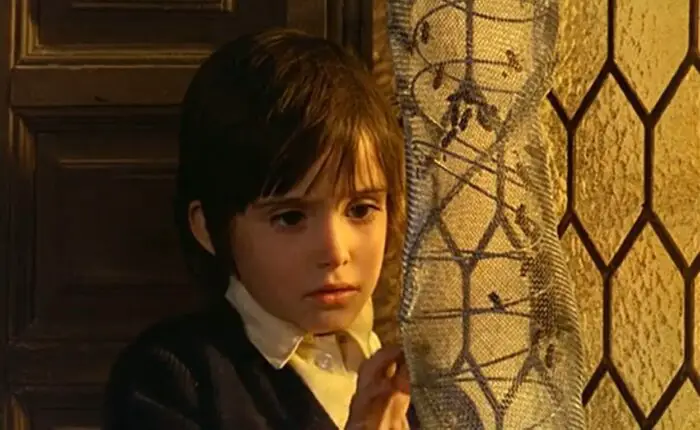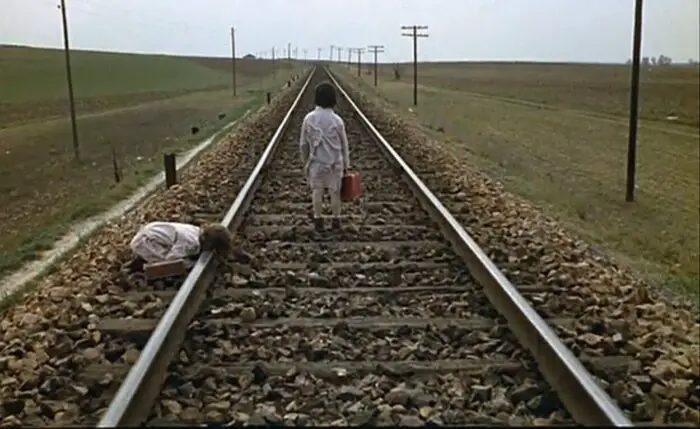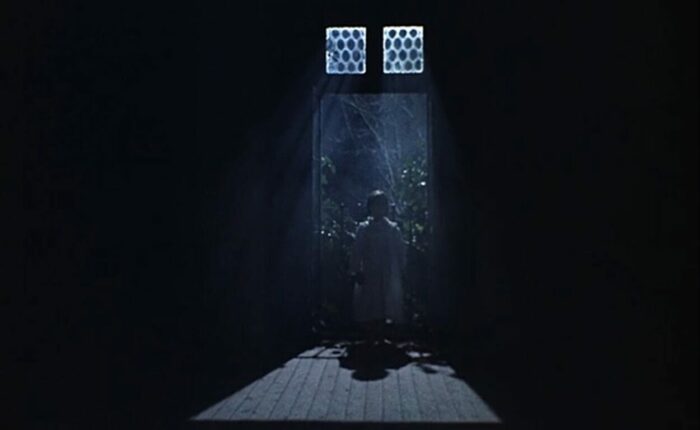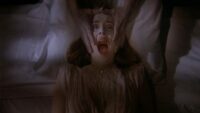The striving of humanity towards knowledge and understanding of the universe is endless. We uncover more and more mysteries and have achieved incredible progress through centuries, but something always eludes us. The secret of life itself is unfathomable for us, perhaps because we are part of it, rather than observers from outside. We pass to our children knowledge and wisdom accumulated through generations, teach them how to distinguish the good from the bad. But adults can’t teach children things they themselves don’t understand. Each of us, eventually, has to experience life in our unique way and make our own connections to it. The Spirit of the Beehive lets us watch how one such little human beings—a young girl named Ana (Ana Torrent)—tries to make this connection in her own way.
The Spirit of the Beehive is the first feature film of Spanish director Victor Erice made in 1973, near the end of the Francoist regime. The film—one to which Guillermo del Toro’s The Devil’s Backbone owes a significant debt—takes its tile from The Life of the Bee—the work of Maurice Maeterlinck where the author talks about ‘the spirit of the beehive’ as an invisible and incomprehensible force that rules the life of the bees.
Set in approximately 1940, The Spirit of the Beehive takes place in the first years of the Francoist regime. There are forces that rule any community, but in authoritarian societies those forces are especially strong. Not all of the rules are clearly stated. Some are implied. People, including those opposing the established regime, like, we can assume, Ana’s father Fernando (Fernando Fernán Gómez), learn to survive by obeying the rules without questioning them. But who or what really implements this control? Is it someone specific? Or is it some invisible and incomprehensible force similar to those bees of Maeterlinck?
Fernando lives with his family—wife and two daughters—in a small village isolated from the rest of the world. In the film, it is Fernando who studies bees. He observes them in the glass hive arranged in his study. He is at the same time fascinated and terrified by the order of the beehive, where there seems to be no disease or death, only life and endless busy movement.
Then we look at Fernando’s house with honeycomb-like windows. The sunlight that enters through those windows gives the rooms gorgeous honey-yellow color. It seems as if Fernando and his family live in a hive too, and we, the viewers are observing them.

Fernando, who we can assume was a supporter of Republicans, now lives a quiet life with his family trying to adapt and survive. He is intellectual and operates more in the spiritual realm than in the real world. His way of understanding life is through reasoning. It’s probably not incidental that Fernando’s study is located on the highest level of the house. I don’t think that his work and knowledge are demanded in a society like this. His work probably feels as aimless and vain as he sees the work of his bees.
Fernando’s house is not the only edifice to resemble the beehive. The school where the little girls go with a busy air, wearing their uniform coats and carrying school bags., makes them appear a little like little worker bees entering the hive. I can imagine, they receive the education which, as in every authoritarian society (or perhaps more or less in any society) is aimed at making the perfect and useful members of society from them.
The village where Fernando’s family lives is separated from the outer world. News reaches there with delay. The only connection seems to be a train that brings or takes people or letters. And sometimes cinema comes to the village, bringing new and unusual experiences. The film starts with one such occasion. Villagers gather at the city hall to see Frankenstein. Ana and her older sister, Isabel, are among the viewers.
This is where it all starts. We watch Ana as she experiences things she cannot grasp. She is deeply affected and needs the answers. Why did the Monster kill the girl and why did they kill the Monster in the end? She asks Isabel who, unlike Ana, doesn’t believe the tricks of the cinema and tells her that it was all lies, nobody had really died. She tells Ana that the monster was, in fact, an immortal spirit and she can even communicate with it. Of course, Ana believes her.
Lies are one of the mechanisms used for control in repressive societies. Not much is needed to support them. People are inclined to add more and more lies to them. It’s a defense mechanism, I suppose. And cinema also can be and, unfortunately, sometimes is used as a tool for control.
Isabel is right about one thing—cinema uses deception and creates illusions, it can create monsters and evoke fear. And even when we know it’s an illusion, watching films we still experience real feelings. Through manipulation like this, films can make us look into our depth and darkness. But our own darkness frightens us.
Isabel reveals the deception of cinema but makes up another lie about the spirit. She uses it to play tricks on Ana, though in a very childish way. But in the end, the lie becomes real even for their creator—Isabel. If initially she was sure that everything in films is a trick, that shadows on the screen are not real, later the results of her own made-up story affect her too and she starts to be afraid of the shadows appearing on her bedroom wall. Ana’s belief made everything real.
Perhaps what really matters here is not the lie or illusion itself, but the perception of it. Any lie can turn out to be more true and more real than reality. It’s only a matter of attitude. From Isabel’s lie, Ana creates her own fantasy which, for her, can be a way out of the illusion of everyday life.
According to popular belief, one of the first experiences of cinema was associated with fear that was caused by the image of a train. I’m talking, of course, about that famous screening of the Lumiere brothers, when people jumped from their seats seeing the train coming onto them from the screen. They believed in the reality of the images on the screen, just like Ana believes. And later in the film the incarnation of the Spirit, as Ana believes, comes with this first ‘monster’ of the cinema in the form of a fugitive Republican. When Ana finds the fugitive, she immediately assumes that he is the Spirit who has put on the body, like Frankenstein’s monster in the film.
We can see the train as another manifestation of that repressive force. The train can crush everything on its track. The image of Ana staying too close to the rails when the train is approaching reflects her attitude toward the Spirit. Like her father is fascinated by the beehive, Ana is enchanted by the train. But she is yet unaware that she should be afraid.

Spirit Ana is trying to befriend is an entity beyond ordinary, structured, controlled life. It is immortal and thus, out of time. It ‘materializes’ in a fugitive who came with the train that moves on fixed rails with a fixed schedule. The train is a part of the order, an organized mechanism that obeys time and symbolizes its unstoppable and relentless nature. Trying to help the fugitive, Ana brings him her father’s jacket where the fugitive finds a pocket watch. He does the magic trick and makes the watch disappear. He—the Spirit—literally plays with time.
When the fugitive is killed and Ana’s secret is revealed, she, confronted by her father, runs away. What did she imagine there? Did she think her father had something to do with the killing? Maybe he did, as a part of the society that killed him?
Ana runs away and goes into the darkness even deeper. She meets the Spirit/Monster in the woods, by the river. The scene from Frankenstein becomes real for her. There is no difference between inner and outer reality for Ana, anymore. Before the monster appears, we see that she projects Frankenstein’s monster when looking at her own reflection in the water. It is the spirit, as she believes, and the Spirit is part of her. Ana survives meeting with her own spirit/monster but, as a result, becomes detached from her family. She lives in the night world now and is not afraid, unlike her sister.
In the ending scene, the light and colors show this change that happened in Ana. The honeycomb-like windows look different in the moonlight. The night is the time when the order of the day loses its grip, the time when spirits come out. Ana calls the Spirit again, repeating her name: ‘Soy Ana’, and we hear the sound of the train as if the Spirit has responded. Ana stands in the shadows. And maybe in a repressive society, going deep into oneself is the only way to keep personality.

So what is this Spirit? Is it a repressive force that makes us live in a strictly ordered way? Or is it also something that stays alive while its many flesh ‘clothes’ come to life and die, time and time again? Spirit is not good or evil, it just is. It persists. As life persists. This force keeps things going, like in the beehive—without pity and remorse. Not a comforting thought, but perhaps “the spirit of the beehive” is something we need to survive dictatorships and tyrannies, in whatever form, be it outer or inner, literal or figurative.



